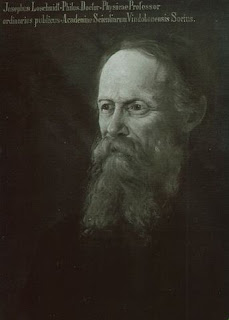| Amedeo Avogadro (1776-1856) |
| Stanislao Cannizzaro (1826-1910) |
Few scientists, however, were concerned with how many molecules were actually in that volume of gas. They were more concerned with the hypothesis itself and what that meant for being able to determine other properties of matter, such as how big atoms and molecules actually are. The next step in determining Avogadro's number takes us from Avogadro and Cannizzaro in Italy to Austria, where Johann Josef Loschmidt (1821-1895) was working.
 |
| Johann Josef Loschmidt (1821-1895) (image from Wikimedia commons) |
Loschmidt wanted to find out what the actual size of a molecule of a gas was, and used current theories of gases to determine this. Rudolph Clausius had derived in 1859 the mean free path of molecules in a gas in terms of the cross-sectional area, and James Maxwell derived his own expression the following year. Loschmidt then calculated what fraction of the gas was occupied by the molecules themselves based on the mean free path and then assumed that when the gas is liquefied, the volume is only slightly larger than that of the molecules themselves. The problem then was the air had not been liquefied, so he used the work of Hermann Kopp to estimate the density of liquid air. He determined that the size of a nitrogen molecule was 9.69*10-10 m, or about three times too big. But not bad. However, despite knowing how big molecules were, no one seemed particularly concerned about how many molecules were in a region of space. A following paper in 1865, ostensibly by Loschmidt, states that a cubic millimeter of gas contains 866 billion molecules, but that wasn't the point of the article.
Studies of gasses over the course of the rest of the century and into the 20th century would help to elucidate the question of how many molecules are in a given volume, but I will leave that for another day! Check back soon (or subscribe to the emails) for more information about the definition and calculation of Avogadro's number and where the name mole came from.
Original Papers in order of publication
- Amedeo Avogadro, "D'une manière de déterminer les masses relatives des molécules élémentaires de corps, et les proportions selon lesquelles elles entrent dans ces combinaisons", Journal de Physique 73, (1811), 58-76. (Or in English: "Essay on a Manner of Determining the Relative Masses of the Elementary Molecules of Bodies, and the Proportions in Which They Enter into These Compounds")
- André-Marie Ampère, Annales de chimie, 90, (1814), 43.
- Hermann Kopp, "Ueber die specifischen Volume flüssiger Verbindungen", Justus Liebigs Annalen der Chemie 92, no. 1 (1854) 1-32. DOI: 10.1002/jlac.18540920102
- Stanislao Cannizzaro, "Sunto di un corso di Filosofia chimica, fatto nella Regia Università di Genova", Il Nuovo Cimento 7, (1858), 321-366. (Or in English: "Sketch of a Course of Chemical Philosophy Given in the Royal University of Genoa")
- Johann Loschmidt, "Zur Grösse der Luftmoleküle", Sitzungsberichte der kaiserlichen Akademie der Wissenschaften Wein 52, no. 2 (1865) 395-413. (English translation "On the Size of the Air Molecules" included in "Loschmidt and the Discovery of the Small")
- Johann Loschmidt, Z. Math. Phys., 1865, 10, 511-512.
- Alexander Naumann, "Das Avogadro'sche Gesetz abgeleitet aus der Grundvorstellung der mechanischen Gastheorie", Berichte der deutschen chemischen Gesellschaft 2, no. 1, (1869) 690-693. DOI: 10.1002/cber.186900201274 (Or in English: "Avogadro's Law Deduced from the Fundamental Conception of the Mechanical Theory of Gases", Philosophical Magazine 39, (1870) 317-320)
References
- N. G. Coley, "The Physico-chemical studies of Amdeo Avogadro", Annals of Science 20, no. 3 (1964), 195-210. DOI: 10.1080/00033796400203064.
- Ronald J. Duchovic and Joel A. Vilensky, "Mustard Gas: Its Pre-World War I History", Journal of Chemical Education 84, no. 6 (June 2007), 944-948. DOI: 10.1021/ed084p944.
- Jaime Wisniak, "Amedeo Avogadro: The Man, the Hypothesis, and the Number", The Chemical Educator 5, no. 5 (2000), 263-268. DOI: 10.1007/s00897000420a.
- L. Cerruti, "The Mole, Amedeo Avogadro and Others", Metrologia 31 (1994) 159-166. DOI: 10.1088/0026-1394/31/3/001.
- Alfred Bader and Leonard Parker, "Joseph Loschmidt, physicist and chemist", Physics Today 53, no. 3 (2001) 45-50. DOI: 10.1063/1.1366067
- William W. Porterfield and Walter Kruse, "Loschmidt and the Discovery of the Small", Journal of Chemical Education 72, no. 10 (October 1995) 870-875. DOI: 10.1021/ed072p870.2